Less than eight months later than their previous meeting in the UEFA Champions League 2020 final, Bayern Munich and PSG met again in the first round of the quarter-finals of the competition they topped last season.
While Bayern came in a similar situation – first in the Bundesliga and with Hansi Flick still in charge – PSG are a very different team now, struggling in the Ligue 1 compared to previous seasons and having changed Tuchel for Pochettino.
This time, PSG were the winners, getting a 3-2 away victory that gives them an important advantage for the second round of the tie. In this tactical analysis, we’ll look at what each team tried to do on the pitch and the tactics used by both coaches to make the most out of their squads.
Lineups
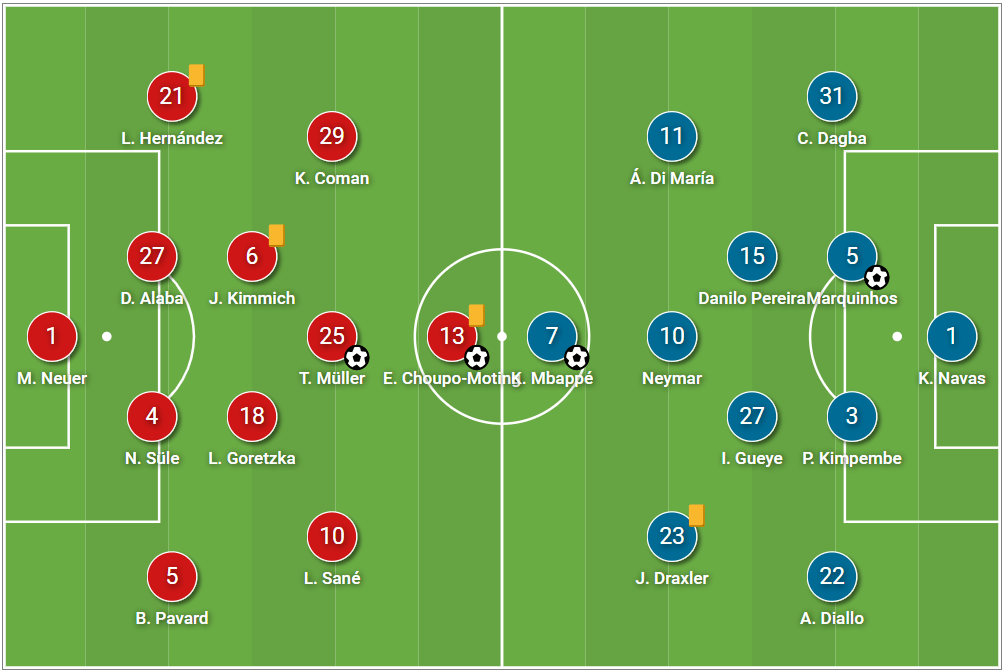
Hansi Flick used a 4-2-3-1 with Choupo-Moting substituting Robert Lewandowski because of injury. Surprisingly, Alphonso Davies was on the bench and Lucas Hernández started, with Alaba playing as a centre-back. In midfield, Joshua Kimmich and Leon Goretzka played behind the free-roaming Thomas Müller with Leroy Sané and Kingsley Coman acting as inverted wingers. As we’ll see in this tactical analysis, Bayern made two changes in the first half to correct some of the issues Flick spotted.
On the away side, Mauricio Pochettino used the same 4-2-3-1 formation with the expected players. In defence, PSG used Colin Dagba and Abdou Diallo on the full-backs as Bernat, Kurzawa and Florenzi were unavailable. With Verratti and Paredes out, Gana Gueye played alongside Danilo Pereira to form a very solid midfield partnership. Julian Draxler appeared on the left side and was in charge of defending and balancing the team, with Ángel Di María on the right. Upfront, Kyllian Mbappé was the most advanced man and Neymar in a free role in attack and in charge of supplying balls to him.
PSG provoking pressure and exploiting spaces
As they usually do, Bayern’s pressure was very well-coordinated and intense, making it impossible for PSG to build comfortably from the back. Bayern’s 5.71 PPDA was their lowest this season in the Champions League, well below their average of 9.41 in the tournament.
By pressing like crazy, Bayern tried to force PSG to commit mistakes and give the ball away but that came with the risk of leaving free spaces behind the pressing players and behind the defensive line too. PSG knew Bayern would press like that so they accepted it and looked to create and exploit those spaces.
PSG attempted to build up with short passes from the goalkeeper but were reluctant to risk the ball. These short passes were aimed at attracting Bayern into a very high press, often inside the box, and then exploit the spaces they left.
Given Bayern’s press, buildup through the middle was almost inexistent from PSG. After their short goal kicks, they didn’t try to continue breaking lines with intricate progressive passes and the risks they took were very controlled and just aimed at dragging Bayern further from their goal and creating space for Mbappé and Neymar to run.
But even if the risks PSG took in the buildup were calculated and they assumed them, they were still risks and Bayern forced some mistakes in their buildup. As the match advanced and especially when they were in front, PSG made fewer mistakes even if that came at the cost of having fewer opportunities to advance.
In the picture below, Bayern’s high press forces Marquinhos to pass the ball quickly to the right-back and he doesn’t realize Leroy Sané can get to it first. The German intercepts the pass and rushes forward, forcing a corner kick.
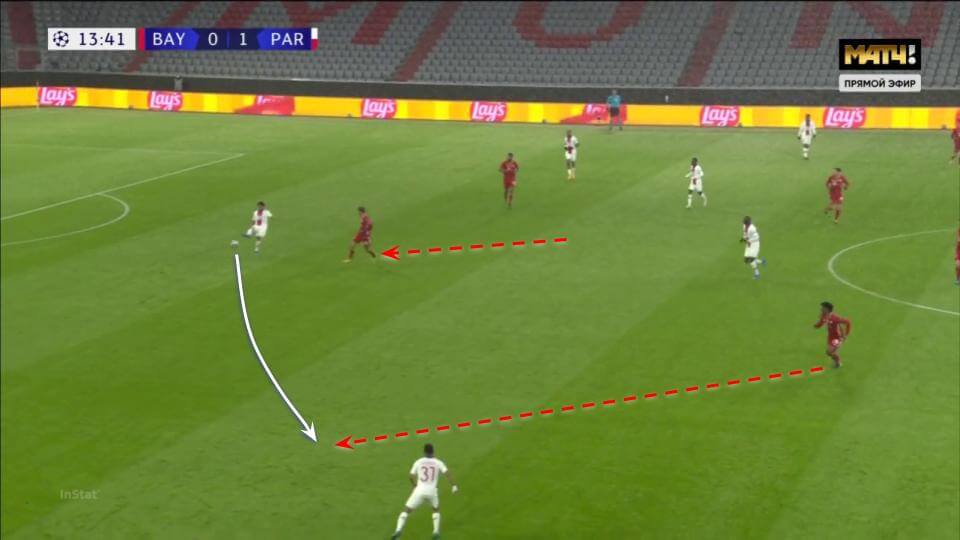
To create passing lanes, Di María and Draxler drifted inside during the build-up, occupying the half-spaces and trying to create numerical superiorities with the full-backs and Neymar, who moved from side to side between the lines. Every now and then, Neymar would drop to the midfield line to receive the ball, attracting one of Bayern’s deepest players and creating even more space.
By having three or four players behind Bayern’s midfield, PSG forced the Bundesliga champions’ defenders to decide between keeping the team compact in the press but leaving huge spaces in behind or staying in their position and leaving that space between the lines. With Mbappé roaming around the defensive line and playing off the shoulder of the centre-backs, this decision was a very difficult one.
Let’s see the example below. This time, PSG found an easy pass to Ander Herrera in the middle and it was PSG’s central midfielders who attracted pressure from Kimmich and Alaba. The Austrian allows Herrera to turn as he wasn’t pressing as much as Kimmich and allows a pass to Neymar, who receives between the lines and with plenty of space to turn and create.
In the exact moment of the picture we can see Neymar and Di María positioned in central areas between the lines, Draxler also between the lines but wide and Mbappé in an offside position but ready to run into space. In this situation, Bayern’s defensive line doesn’t know what to do and leave lots of space (marked with the black lines) for the players in the second line to play in, in this case, Neymar. The play ends with the Brazilian number 10 assisting Mbappé, who faces Neuer but was offside.
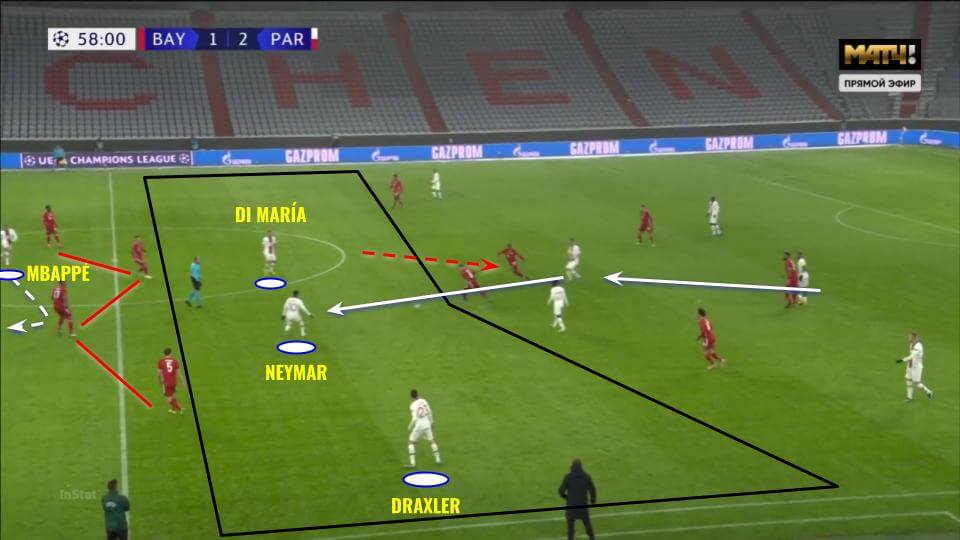
PSG knew that normally they wouldn’t be able to play through the middle so they also designed ways of advancing by the wings. Once the ball was on the wings, PSG looked to combine quickly to attract pressure. One of the creative players, mostly Neymar, would support these combinations, attracting one of Bayern’s central midfielders and then run from that deep position looking to receive the ball into his run and between the lines, ready to face the defensive line and exploit Mbappé’s pace. With Bayern pressing so aggressively, one of their central midfielders was very often isolated if PSG managed to play through the press.
Mbappé was key in PSG’s plan even when he wasn’t directly involved in the attacks. His pace was a constant threat and he was always moving between the centre-backs and the full-backs, forcing them to stay deeper than they would ideally want to with the centre-backs doubting between pressing Neymar or narking him, Mbappé found plenty of space to use his lighting pace and receive passes from Neymar and Di María. With the spaces Bayern left in behind, his pace was unstoppable.
PSG didn’t look to move the ball horizontally and almost didn’t have any long possession with Bayern sitting deep. Once they had created space by attracting pressure from Bayern, they looked to play directly and break lines to get forward as soon as possible and if Bayern recovered their position they played backwards to attract them again and restart their plan.
PSG’s first and third goals reflect very well what they looked to achieve with their tactics. The first goal starts with the goal kick picture below. Navas passes the ball to the right centre-back inside the box and when he’s pressed, he passes it back to Navas, who instead of trying a risky pass clears it away. There were passing options to Dagba or Gueye but PSG preferred not to take those risks for most of the game.
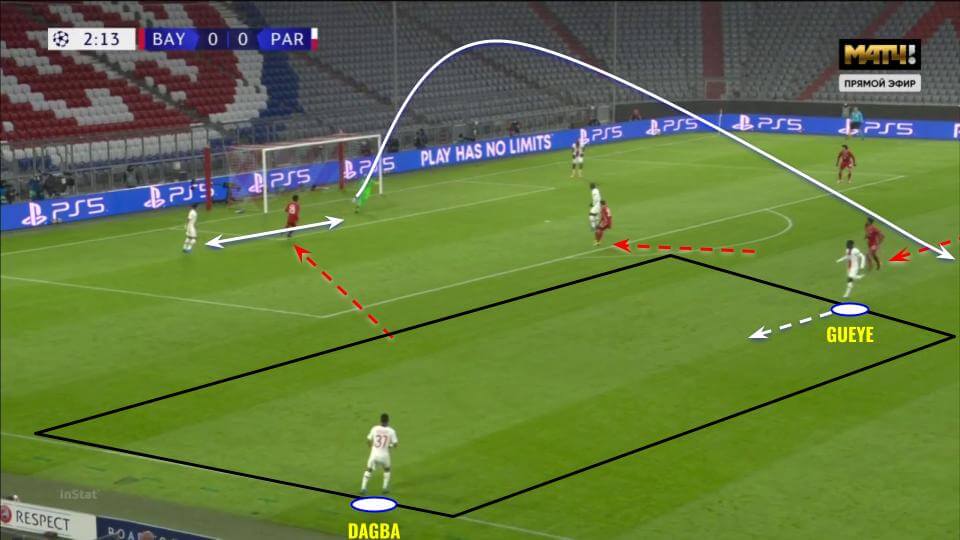
Navas’ pass isn’t accurate but it puts the ball into a zone where PSG have numerical superiority on the right-wing. Alaba wins the header and passes it to Kimmich but Neymar, knowing his role in preventing Kimmich from starting the attacks that we will see in the next section of the analysis, is quick to press him and recovers the ball catching him off-guard as pictured below. PSG are left in a situation that resembles almost perfectly a training rondo with both Bayern players inside.
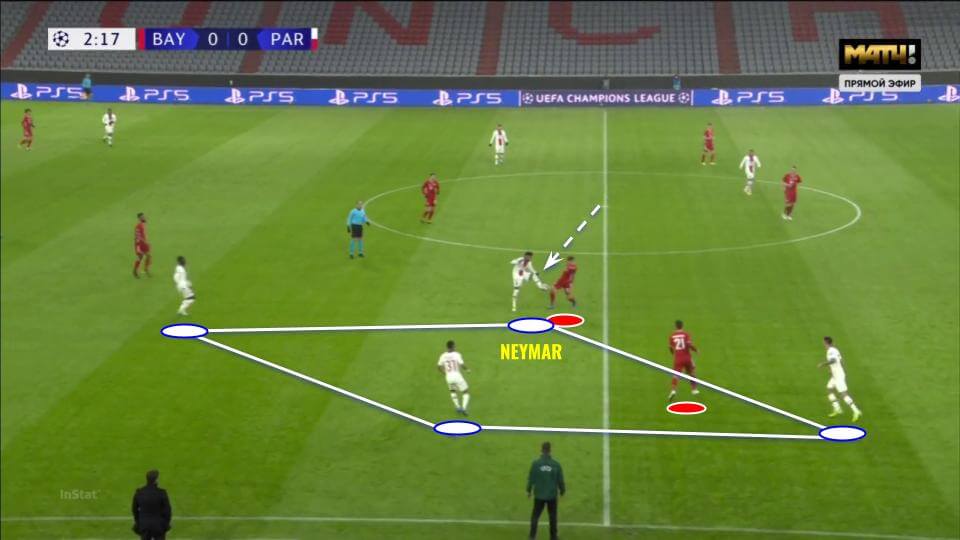
From this rondo-like situation, Neymar combines with Di María and then runs into the space between the lines. Di María returns the ball to him and Mbappé makes the run to drag Süle so Neymar can run until the edge of the box before assisting the French wonderkid. As it was usual before being subbed off in the first half, Goretzka didn’t read the move and couldn’t intervene in the play.
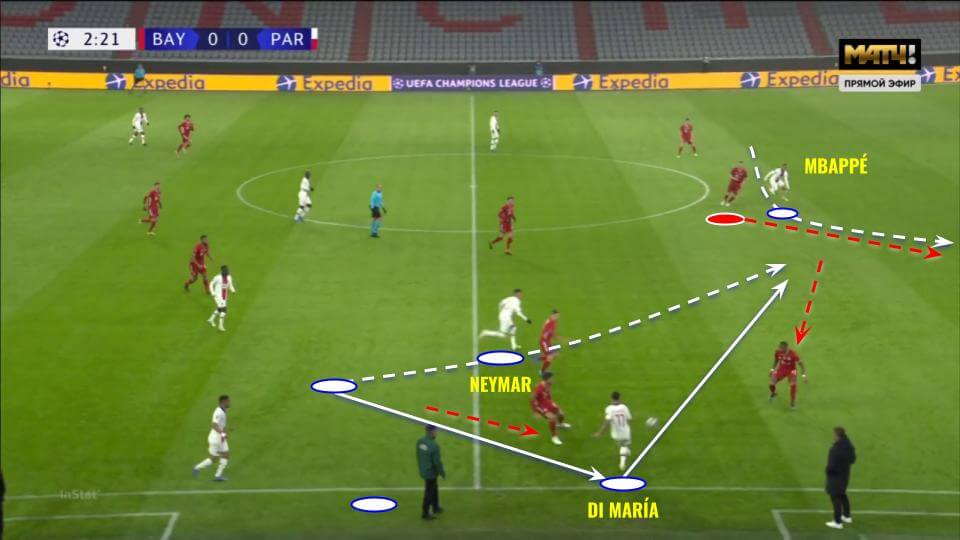
PSG’s third goal is also interesting. The attack lasted 13 seconds and came after a Bayern’s attack that lasted over a minute. PSG let the Germans advance and commit players forward and as soon as they recovered the ball they had the space they needed to attack.
The moment from the screenshot below shows us some key aspects of the play. Herrera receives the headed ball from his teammate’s interception and as soon as he gets it, the attacking trio starts running forward the goal.
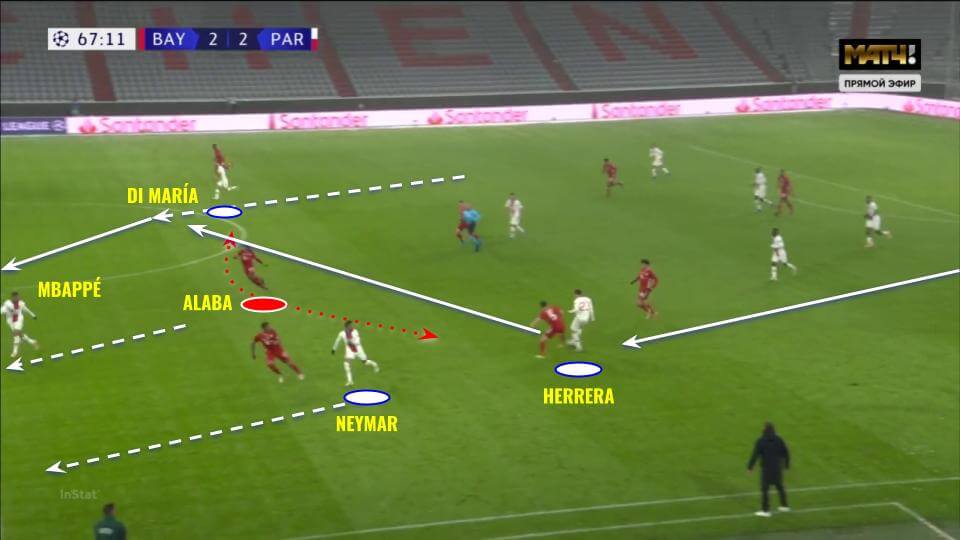
Alaba, Bayern’s deepest midfielder on this occasion, can’t cover the whole width of the pitch so Herrera has an easy passing option to Di María, who has left Alphonso Davies behind. When the Argentinian receives the ball, he has two relatively easy passing options in Neymar and Mbappé, who have already distanced themselves from their markers. Mbappé receives the pass and produces a moment of magic.
Despite the finishing being the fruit of Mbappé’s talent, the play was exactly what Pocchettino wanted to achieve with his team sitting deep and provoking Bayern. We’ll later review the xG for this match but it seems clear that the chances PSG created were much better suited to their players than Bayern’s.
Bayern’s fixed gameplan and PSG’s stoic defending
As a part of their plan to attract Bayern and create spaces for their forwards, PSG didn’t look to press for most of the game, keeping a middle block and focusing on blocking passing lanes rather than on challenging the ball possessor. They allowed 17.9 PPDA while their average in the current Champions League is 12.46.
Oppositely to his usual freedom, Neymar was given a specific role in PSG’s defensive system and worked hard to fulfil it. He was in charge of marking Kimmich in Bayern’s buildup, forcing centre-backs to take responsibility and progress the ball. With Di María and Draxler marking the full-backs, this left a lot of space for the centre-backs to advance with the ball into the opposition half and try to create from there. Alaba was the most active in the buildup, often advancing beyond the midfield line, but the right centre-back, be it Süle or Boateng, also had space and was given the confidence to advance as much as possible.
Wingers remained wide during the buildup, giving the advancing centre-backs the option to play long diagonal balls and try to beat the full-back in the one-on-one situation. This was mostly done by Alaba again, who felt very comfortable stepping out of the defensive line and switching the game to Sané as soon as a PSG player pressed him. Müller also looked to provide width when one of the wingers drifted inside.
In the play shown below, Alaba receives the ball in his half and with Neymar marking Kimmich, he has lots of space to advance and get into PSG’s half. Once he reaches a rival, he throws a long diagonal pass to Sané, who’s providing width on the right side.
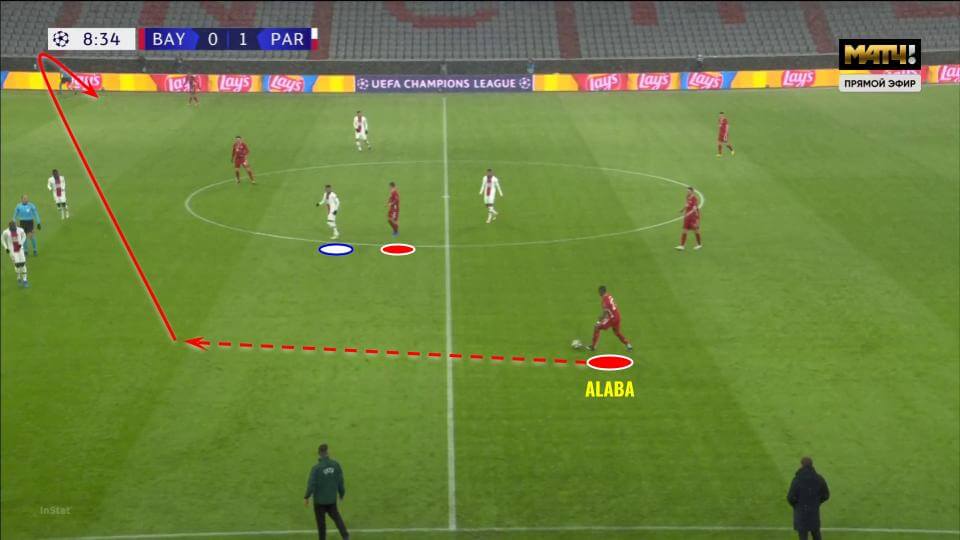
As a result of the wingers wide positioning, Bayern full-backs were often positioned in the half-spaces around the final third, ready to control any counterattack attempts from PSG and also crossing from deep or making runs forward when the wingers received the ball. There were lots of underlapping runs from the full-backs to populate the box and stretch PSG, giving the wingers more space to dribble and cross.
Bayern’s first goal is a good example of the full-backs position slightly more central than usual. At the beginning of the play, pictures below, Davies drives the ball forward looking to get central and push PSG into their own box before passing it to Coman, who’s providing width.
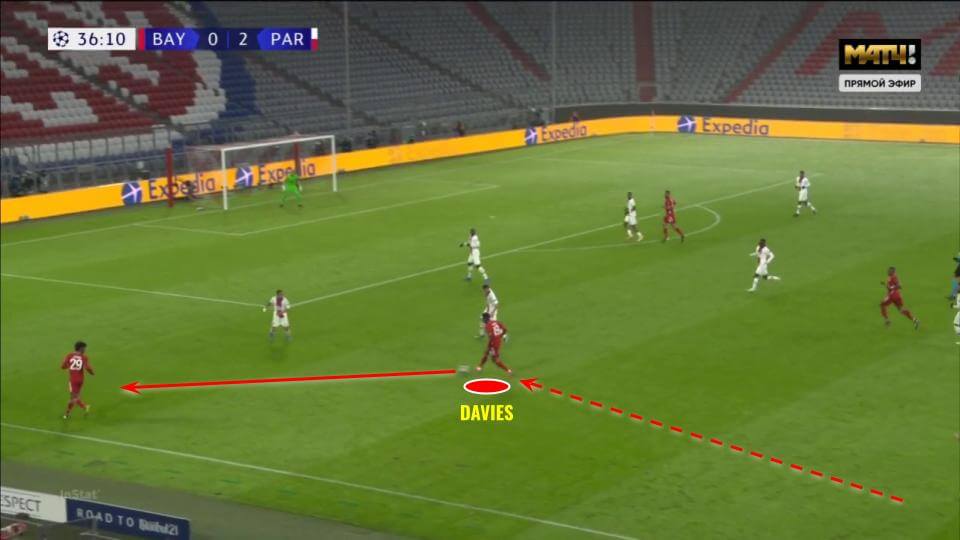
With PSG deep in their box, Bayern move the ball quickly to the right side, where Pavard is quite central rather than overlapping Sané. PSG has all their players very deep and can’t prevent him from crossing, resulting in the goal from Choupo-Moting. Notice how Davies is controlling a possible counterattack by marking Di María on the bottom-left part of the picture and also Neymar close to Kimmich as we mentioned before. We can also notice that Bayern always had four or more players in the box, in this case, Müller, Choupo-Moting, Alaba and Coman who doesn’t appear in the picture.
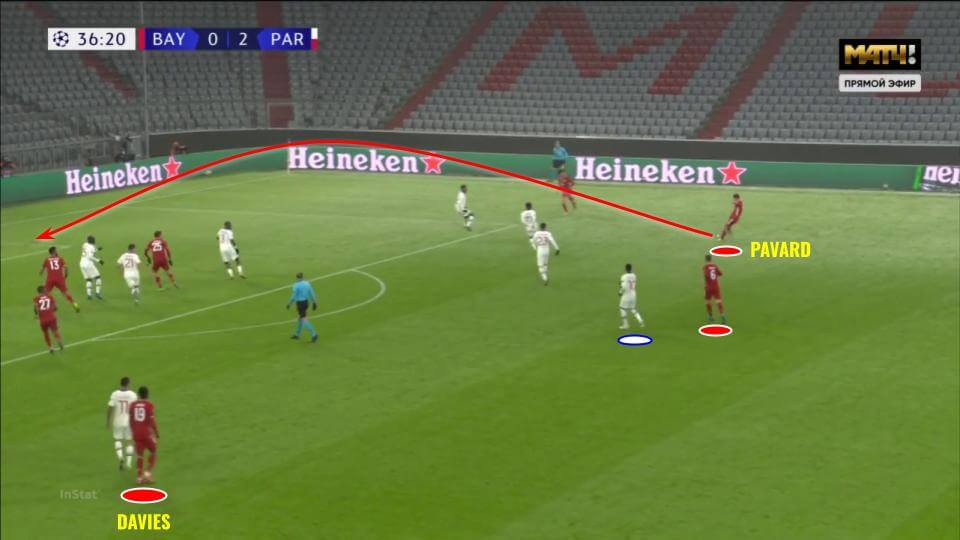
Bayern didn’t change their game plan at all during the game. They went fully attacking during the 90 minutes, always looking to get numbers into the box and press very high. They did make some tweaks when they spotted problems though but without changing their idea
In the first half, Goretzka was taken off because PSG forwards were finding lots of space behind his back and he didn’t have the mobility to help Kimmich. By putting Alaba in midfield, Bayern gained control, more options in the buildup when Kimmich was blocked and someone more mobile and capable of coping better with pacey rivals. The change of Süle meant Hansi Flick admitted his mistake with the starting XI as he wasn’t capable of dealing with the pace of Mbappé and Neymar.
PSG, while also maintaining a quite low block and not pressing much, did make some changes in some parts of the game. In the first 15 minutes of the second half, they tried to press higher and prevent Bayern from dominating as much. However, the defensive line didn’t seem to cooperate and it resulted in PSG being a very long team and Bayern finding ways to play through their press and more space in the attacking half. Alaba felt very comfortable here, receiving the ball higher up the pitch and attacking spaces constantly. This didn’t last much and as soon as it changed, PSG scored the third.
Another change that affected the game a lot was Marquinhos’ injury. PSG didn’t have any trustable centre-back option on the bench and it was Danilo Pereira who had to play there despite not being in his natural positions. With Marquinhos, the French champions felt much more in control of the box but Danilo wasn’t as good and he was at fault in Bayern’s first goal as he wasn’t marking Choupo-Moting. Also, Ander Herrera didn’t offer the same defensive cover as the Portuguese.
An unfair result? Questioning xG
While it was clear Bayern dominated the game and had more and better chances, looking at the xG doesn’t make justice for the match. According to infogol, Bayern registered 4.28 xG and PSG just 1.65.
But if we look at chances valued at 0.3 xG or more, Bayern registered five and PSG four. Both Bayern goals came through these chances for only two of PSG’s as Mbappé’s final goal was worth just 0.11 xG. Also, both Bayern’s clearest chances were valued at 0.53 and 0.59 because they were from a very close distance and with no opposition but in both of them, the ball came from high and players had to adjust their body shape very quickly so they didn’t seem as dangerous to the eye.
It’s not the goal of this tactical analysis to question how xG models work as they can be (and are) really useful. But claiming it was a lucky win by PSG leaves a lot out of the analysis as they looked for a match like the one they had and got away with it. Knowing they had the players with the pace and quality to take advantage of any spaces Bayern left, PSG didn’t need to create too many chances to score. On the other side, Bayern looked to put as many balls in the box as possible, something that would’ve made a lot of sense with Lewandowski but wasn’t as effective with worse finishers.
Another aspect of xG we must keep in mind when analyzing the tactics of this match are the set-pieces. Bayern registered 2.05 xG from set-pieces (48.3% of their shots). By no means set-pieces aren’t important (they’re one of the most overlooked aspects in football) but they aren’t a direct consequence of the attacking plan. Bayern Munich generated a very similar threat from open play and PSG were open to accepting the risk of conceding lots of shots knowing they have one of the best shot-stoppers in the tournament in Keylor Navas.
Conclusion
Bayern and PSG gifted the neutral spectator with a fantastic match of football. With opposed styles, both managed to get good chances and stick to their plan. This time it was PSG who were more effective, finishing clinically and focusing on creating those chances that benefited more their players. Navas also deserves mention as he was a key part of PSG’s victory, being trusted to stop most of the chances Pocchetino surely knew Bayern were going to create.
The result is fantastic for PSG but the development of the match leaves the result of the tie open for the second round. If Bayern manage to have a similar performance but this time with Lewandowski finishing the attacks, they can surely score two or more goals. But this need to score will offer PSG even more spaces and they have the best players in the world to exploit them in Neymar and Mbappé.





Comments